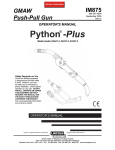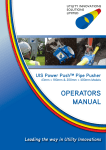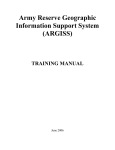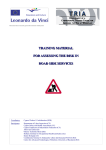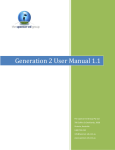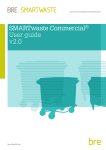Download Health Safety and Environmental Alerts March Newsletter
Transcript
Health Safety and Environmental Alerts March Newsletter Grontmij would like to thank all the clients and contractors (listed on the back page of this report) who regularly send us safety alerts/updates which we use to compile this newsletter; this however in no way implies that any of these companies were involved in any of the events reported. Pedestrian crossing fatality It has been reported by the HSE UK and newsfeeds that Luton Airport and a design subcontractor have been successfully prosecuted for the death of a person killed on a pedestrian crossing. The fines for the two organisations totaled £372,595. The Incident A 78 year old passenger was killed when she was crushed under a 26 ton milk lorry as she used a marked pedestrian crossing between the terminal building and a drop-off zone at the airport in May 2009. London Luton Airport Operations (LLAO) was responsible for maintaining the roads, parking enforcement and signage at the airport. This responsibility included the crossing, which was designed by C-T Aviation Solutions. The crossing was on private land not deemed public highway. Although the crossing was not bound to comply with statutory requirements applicable to public roads the HSE successfully won the case on the basis that; based on the risks, it should have included key features of a regulated crossing and that this was reasonably practicable. The HSE said the crossing should have had Belisha beacons, zigzag lines and a stop-line at least 1m from the start of the crossing. Following the case, Inspector Graham Tompkins stated “Although the judge ruled that the design of the road was not a significant cause of Mary Whiting’s death, it did create a serious risk and the sentence imposed reflects the gravity of the offence”. Design team considerations Clearly this is a significant case as there is a multiplicity of various client standards and local design standards and in many cases no standards that can be applied on some private sites many of which may not match the standards for public roads. Within the UK the general practice where set public road standards cannot be achieved is to apply for relaxations or departures. These applications follow a set process and rigorous protocol to ensure the risk is sufficiently mitigated or assessed as adequately covered. Within the national road context there is also road safety audit protocols which assess the safety of the facility in use at various stages giving an opportunity on a number of occasions to pick up hazards and risks. It has not been established if these options were taken advantage of in this case. This case is made more difficult to gauge as the judge deemed the design of the road was not a significant cause of the death but posed a significant risk. This must lead us to the design risk assessment which should cover safety in use and the appropriateness of the design for maintenance, use and eventual dismantling or demolition. Where designs for elements such as this that cannot be accommodated to public road standards then a narrative should be produced to explain the restrictions, the design rationale and the specific design element that does not meet the standard and the potential impact this could have on construction, maintenance staff and asset users. There is no doubt that this may create much discussion amongst design communities from which we may learn in due course. In the meantime maintain a focus not only on construction safety but also on the safety in use and maintenance. The CDM regulations in the UK remain the key design related legislation but this case draws attention for the need to apply the highest technical design standards also and thus one issue for the CDMC community to consider also. For further information on design standards seek guidance from your line manager, team leader or project manager. MAKE IT SAFER Grontmij Ltd, Grove House, Mansion Gate Drive, Leeds, LS7 4DN WWW.grontmij.co.uk 0113 2620000 Health Safety & Environmental Alerts Segregation of plant and people What Happened Sadly, in the early hours of Sunday morning 2nd March 2014, a contractor’s employee was killed whilst working on Docklands Light Railway’s twin-tracking site near Pudding Mill Lane (non Crossrail site). He was performing the duties of a Banksman, and suffered fatal injuries after being struck by the arm of a mechanical excavator. The site was immediately closed by the Metropolitan Police and remains so, pending an inspection by the Health & Safety Executive. Considerations Although this incident is currently still under investigation, the following visuals and associated checks have been developed to assist Crossrail sites in reviewing their arrangements: Fatal incident An employee of a subcontractor on routine surfacing work on the M8 near Glasgow airport was fatally injured at 11.40 on Monday 3 rd March. The resurfacing operative was struck by a reversing asphalt truck and died immediately as a result of his injuries. This is a stark reminder to us all of the risks associated with vehicle movements on site. Areas to consider include: Planning of the site, looking at traffic routes, speed limits, segregation, turning areas and the elimination where possible the need for reversing. Where reversing is necessary the driver needs to be instructed and escorted by a banksman at all times. PPE is the last means of defence. It is not a shield but it must be worn correctly, it must be clean and visible and if there are any problems with it then they must be rectified. The last but one of the most important aspects to manage is behaviour. Disciplining those who fail to comply, show that safety is a condition of employment and responsibilities will turn to accountability. MAKE IT SAFER Grontmij Ltd, Grove House, Mansion Gate Drive, Leeds, LS7 4DN WWW.grontmij.co.uk 0113 2620000 Health Safety & Environmental Alerts Manhole cover dropped Causing RIDDOR injury A subcontract employee injured his shoulder whilst replacing a manhole cover.Whilst lifting the 750x600mm cover with a colleague using manhole keys, one of the keys slipped out and the cover dropped into the opening leaving the injured party (IP) taking all the weight. The IP pulled a muscle in his shoulder resulting in him being away from work for more than seven days and being reported as a RIDDOR injury. Following a detailed investigation, the root causes were identified as being: Failure to complete a specific manual handling assessment for the task The use of short manhole keys not allowing for a good lifting posture (as illustrated bottom left picture) The subcontractor completed extensive trials after the incident to look at alternative equipment which allow for better posture and for the equipment to be fixed to the cover. The picture above (right) shows the alternative equipment selected for use by the Subcontractor post incident. The 2-man manual manhole cover lifting arms allow for: Better lifting posture to be adopted – i.e. no stooping Greater distance between the person lifting and the cover The lifting arm to be secured in place with a lock nut to prevent twisting The cover to be ‘cracked’ to remove the seal before lifting There are many other alternative pieces of lifting equipment on the market which can be selected to safely lift manhole covers without the need to rely on using manhole keys. Learning points Use mechanical manhole lifting equipment in preference to manhole keys if appropriate If you need to use manhole keys: Make sure they are the right keys for the cover Avoid using keys which are too short, resulting in a stooped upper body position Check the cover is not seized before lifting, loosen covers by breaking seal Asbestos in floor screed During some minor works within a block of flats, traces of asbestos were found underneath and within a concrete floor screed. This had not been identified in the asbestos survey, and was not apparent until the screed was being taken up. The client have their own specialist asbestos team, who had not come across this material (despite many years’ experience), and on consulting the HSE they indicated that they had rarely come across it (although it is included in appendix 2 of the Surveyors Guide HSG 264 as used around WCs and in industrial applications). MAKE IT SAFER Grontmij Ltd, Grove House, Mansion Gate Drive, Leeds, LS7 4DN WWW.grontmij.co.uk 0113 2620000 Health Safety & Environmental Alerts The screed was identified as “Magnesite (Magnesium Oxychloride) Flooring.” Action Where work is required to a floor screed or laid toppings, check that the Refurbishment or Demolition Survey has included an investigation and sampling of floor screeds and it has not been assumed that it is a sand/cement screed. Teams working on an existing floor screed, must cease work if there is a reddish colour to the screed and obtain confirmation as to the nature of the material. All sampling and testing must be undertaken in accordance with the Asbestos Management Procedure by asbestos surveyors or analysts. Further Information Magnesite flooring was very popular for domestic applications in the period 1920 to 1940, and for Local Authority housing between 1945 and 1960. It is usually a reddish pink colour although some floors were coloured using pigments. It was typically laid between 10 and 25mm thick, but two coat applications could be up to 50mm thick. Identification It is easy to confuse magnesite with a pigmented sand/cement screed, however the following feature can aid identification. Magnesite flooring is electrically conductive and so an electrical resistance moisture meter will give a full scale damp reading even when the material is bone dry. Cable strike During a recent operation to lay a new water service in Central London an 11kV high voltage cable was struck by a machine mounted pecker. There were no injuries sustained. The utility drawings indicated two HV cables situated on the opposite side of the road. The team picked up a signal on the cables and thereby assumed the drawings were accurate. However they were not as a cable deviated to the side of the road the team were working in. This wasn’t traced by the team. Key Points You must never assume that the drawings are correct. They are an indication only and should BE USED AS A GUIDE Whenever you use a Cat – You SHOULD ALSO USE THE GENNY, there are no acceptable excuses You should never use any form of mechanical tool in the 500mm exclusion zone until depth of services are identified MAKE IT SAFER Grontmij Ltd, Grove House, Mansion Gate Drive, Leeds, LS7 4DN WWW.grontmij.co.uk 0113 2620000 Health Safety & Environmental Alerts Please refer to the Utility Strikes Design Bulletin on iShare for further information. Gas leak near excavation During the excavation of a 1.2m deep trench to create a FLIP chamber. The team had exposed a cast iron gas main. The gas main was believed at first to be a water main as the service drawings showed the gas main to be outside of the excavation footprint. The gas main crossed the excavation horizontally. The team ratcheted the pipe to support it over the excavation. The first frame for the temporary works was put in and the team began to dig down to place the second frame. At this point National Grid informed the team there had been a report of a smell of gas in a local residence. The team stopped work immediately and a local resident was evacuated for one night. There had been no written report from National Grid, but there has been verbal confirmation that the cause of the leak was an open joint in their main. When the excavation was elongated by National Grid to expose the joint they discovered that their cast iron pipe had been constructed with seven separate joints and the top of one flange was only 250mm below the surface. One of the joints in the main had become loose creating the leak. The joints and the depth of the gas main below the surface can be clearly seen in the photograph below. Actions All shallow services should be reported on a hazard identification card. Reminder to all that pipes can deviate from expected routes. Always follow safe digging practices e.g. trial holes, safe dig packs and permits to break ground. On this occasion, had safe practices not been used this could have resulted in an explosion which could have resulted in injuries. Danger at streetworks A technician was recently carrying out a data logger exchange on a fire hydrant, which was situated within a footpath on a housing estate, adjacent to a house driveway. Although the technician had erected barriers and cones around the hydrant, a vehicle reversed out of the driveway and struck the barriers, causing the technician to take emergency evasive action. The vehicle did not stop, but fortunately the technician only suffered a small cut to his finger. Reduce RISK by the following actions: ALWAYS carry out a Site Specific/Point of Work Risk Assessment when arriving at a new place of work, or if a new situation develops When Lone Working, ensure that you follow the Lone Working Procedure When working in the highway on a fixed asset such as a meter or fire hydrant, erect signing lighting and guarding in accordance with the Red Book “Safety at Street Works and Road Works” Where appropriate, position your vehicle with beacons flashing and chevron livery facing traffic hazard If your vehicle or signing and guarding is likely to impede access to domestic or commercial premises, contact the occupier before commencing work In the event of a conflict with an occupier refer to your Line Manager Keep your mind on your surroundings and potential hazards Always protect yourself before your equipment Never assume it won’t happen to you! MAKE IT SAFER Grontmij Ltd, Grove House, Mansion Gate Drive, Leeds, LS7 4DN WWW.grontmij.co.uk 0113 2620000 Health Safety & Environmental Alerts Using correct tools A technician was recently carrying out routine leakage detection work in a DMA, which involved operating sluice valves in a standard step test. When the technician went to get his valve key and bar from the back of the van he found that the racking had partially collapsed, trapping the long bar necessary for the job. He attempted to operate the valve with a shorter bar, and the reduced leverage caused him to exert greater force than normal resulting in a sprain injury to his hand. Reduce RISK by the following actions: ALWAYS carry out a Site Specific/Point of Work Risk Assessment if a new situation develops If you are unsure or unhappy about any aspect of your task, contact your supervisor Only use the correct tools for the job, never ‘Make Do’ If a valve cannot be operated within your physical capabilities, raise a job request with your supervisor for hydraulic actuation Report any defects with your vehicle as soon as you become aware of them Never assume it won’t happen to you! You are responsible for checking the safety of your equipment – this includes your van and its contents Potential dangers from livestock There have been recent reports of water company employees and their contractors sustaining injuries while working in fields where cows were present. Incidents of this kind are quite common, and often involve bulls or cattle with young. Other kinds of livestock can also give problems, such as rams or goats. Cows are naturally curious, especially when hand-reared, but their physical presence can be intimidating and create a dangerous situation. Reduce RISK by the following actions: ALWAYS carry out a Site Specific/Point of Work Risk Assessment when arriving at a new place of work, or if a new situation develops If the Risk Assessment identifies that cows or other livestock have young present, bulls or other potentially aggressive male animals are in the field, or that the livestock appear aggressive, noisy or agitated, then DO NOT ENTER When Lone Working, ensure that you follow the Lone Working Procedure and notify your Buddy if you are entering a field containing livestock Where appropriate, contact the farmer or landowner to see if they can move the livestock to another field Only enter a field if you are satisfied that it is safe to do so Do not enter a field carrying a bag or a jacket slung over your shoulder as cattle may think that it is a bag of feed Where possible, take your vehicle into the field to protect yourself Under no circumstances enter a field if there is a dog (accompanied or on its own) nearby that could disturb the livestock Keep an eye on the livestock, but remain mindful of ground conditions If possible stay close to the fence boundaries and always have a planned exit point MAKE IT SAFER Grontmij Ltd, Grove House, Mansion Gate Drive, Leeds, LS7 4DN WWW.grontmij.co.uk 0113 2620000 Health Safety & Environmental Alerts Working at height A Minor Civils Framework Contractor was asked to carry out repairs to a flat roof that was leaking above the building’s electrical control panel. As storm conditions were forecast and some of the roofing felt had already ‘blown off’, the job was deemed an emergency. Lessons Learnt ‘Nothing is so important that we cannot take the time to do it safely’ is a statement we must live by. In this case the electricity supply was isolated and the job wasn’t a true emergency. Attempting to carry out the roof repair without adequate edge protection (only a small parapet wall approx. 300mm high) and in very windy weather conditions posed a greater potential risk than the electrics. The contractors engaged to do the job rarely carried out roof work and were not fully aware of their legal obligations when working at height. Neither the contractor nor the staff involved with the repair had identified that permits were required for working on the roof and for the hot work associated with the re-felting process. The contractors had been issued with a Local Site Asset/Access Authorisation which allowed them “blanket access” to a number of sites. Although there were some limitations associated with the authorisation,this did not extend to work at height. Because this work required a ‘Permit to Work’ it should have been deemed ‘high risk’ and should not have been passed to this (minor civils) Framework Contractor. It should have been passed to a Local Delivery Partner Framework Contractor. Inappropriate use of a listening stick A Leakage Technician was carrying out routine leakage detection activities in a DMA. Water was found running into two manholes around 10 to 15 metres apart in a grass verge. The Technician began prodding the grassed area with a listening stick looking for signs of leakage, but on pulling the stick back out the wooden head the listening stick became detached. Not realising that this had happened, the Technician went to push the stick in again and his left hand came into contact with the sharp unfinished metal end of the stick. This resulted in a severe laceration to his hand which required hospital treatment and seven stitches. The Technician was unable to resume normal working within seven days and the incident has been reported to the HSE under the Reporting of Injuries, Diseases and Dangerous Occurrences Regulations 1995 (RIDDOR). Upon investigation it was found that the Technician was not wearing PPE on his hands, and the listening stick was not Hydrosave-issued work equipment. Reduce RISK by the following actions: NEVER use tools for a purpose other than that for which they have been designed. NEVER push a listening stick in to any ground. NEVER use equipment that is defective, but report it to your supervisor immediately. MAKE IT SAFER Grontmij Ltd, Grove House, Mansion Gate Drive, Leeds, LS7 4DN WWW.grontmij.co.uk 0113 2620000 Health Safety & Environmental Alerts Always use your own equipment, NEVER borrow from another person. Always use the correct PPE for the task. Always report Near Misses, Undesired Circumstances or Hazards Spotted. Disciplinary action will be taken against anyone in breach of these guidelines. Rough terrain scissor lift A scissor lift was being used to access the south elevation of a project in order to install curtain walling when it lowered uncontrollably by approximately three metres before the emergency stop activated. Fortunately, no one was injured in the incident. The scissor lift was removed from use, the supplier was contacted and the machine taken away by the manufacturer for investigation. The machine did not crash down but lowered uncontrollably as pressure escaped from the system. The incident happened at 16.15; prior to this, at 10.30, the machine underwent a full check by the supplier’s service engineer who did not find any fault. The scissor lift that failed is less than six months old, with a manufacture date of 16 October 2013. Action taken Scissor lift removed from service. Supplier’s and manufacturer’s engineers to conduct full inspection / investigation into incident. All scissor lifts from the manufacturer to be inspected. Any Model GS4390 removed from service pending results of investigation. Genie safety alert Genie has become aware of secondary boom angle sensor calibrations performed in the field in which the machine’s service manual may not have been followed creating an improperly calibrated machine. An improperly calibrated machine can lead to machine instability resulting in a machine tip over. Action Ensure prior to use that all Genie Z-135/70 machine have had this remedial works undertaken prior to operation. E.g. check service manual or speak to hire company. DO NOT OPERATE unless you are satisfied and confident that this has occurred. Telehandler incident Over the last six months there have been four separate incidents involving heavy plant. Unfortunately in one case this led to a fatality. In other cases it could have resulted in serious injury. Here is what happened in each of the four incidents: 1. A site operative was killed when a tele-handler struck him. The tele-handler was reversing without the aid of a banksman and the man who was killed was not wearing a hi-visibility vest. MAKE IT SAFER Grontmij Ltd, Grove House, Mansion Gate Drive, Leeds, LS7 4DN WWW.grontmij.co.uk 0113 2620000 Health Safety & Environmental Alerts 2. A site operative was injured by a tele-handler which was reversing a considerable distance without the aid of a banksman and the man struck was talking to colleagues at the time. 3. A tele-handler overturned while lifting a load that was too heavy for it. The driver was inexperienced and the lifting plan was inadequate. 4. A tele-handler fell into an excavation. The road was too narrow for the machine, the excavation was not marked or barricaded, and there was no banksman. What action do we need to take? Where possible, segregate plant and equipment from people on site. Remember it is important to constantly review the traffic management plan as the site develops. Organise other (non-construction) activities such as signing timesheets so as to make sure that pedestrians are kept away from the construction areas wherever possible. Ensure that the contractor provides a physical barrier to prevent vehicles and plant running into excavations. Excavations should be backfilled as soon as possible to eliminate the risk. Ensure lifting methods are in place and that everyone understands the lifting specification for each machine. Check that all plant operators have the correct level of training and competency for the machine they are driving. Excavator slew ring failure An incident has occurred at a site involving a 5 Tonne Volvo ECR48C 360 excavator (not a Cross rail site). Whilst tracking the excavator along the carriageway to commence excavation works the body of the excavator partially detached from the chassis. The arm of the excavator was positioned close to the ground, which held the machine. No injuries were sustained. Volvo (Manufacturer) and Chippindale Plant (Hire Company) are currently carrying out a full investigation into the failure. MAKE IT SAFER Grontmij Ltd, Grove House, Mansion Gate Drive, Leeds, LS7 4DN WWW.grontmij.co.uk 0113 2620000 Health Safety & Environmental Alerts Environmental Reports Disposal of road sweeping arisings A road sweeper operating for a Crossrail contract was observed depositing waste water from its tanker into a gully by the side of the road. Discarded road sweeping arisings are regarded as waste under UK Law and if you have that type of waste then you have a legal ‘Duty of Care’. The Duty of Care applies to everyone involved in handling the waste from the person who produces it to the person who finally disposes of or recovers it. If a road sweeper is emptied in an unauthorised location such as the verge of a public highway, this is flytipping. If a road sweeper is emptied into or near drains or rivers without an appropriate water discharge permit or trade effluent consent, this may cause pollution. These are offences, and the environmental regulator could prosecute. To Do Do you know the ultimate destination of your road sweeping arisings? Is the disposal location suitable for the material? Is the correct paperwork in place e.g. waste carrier licence, waste transfer notes, permits for disposal? MAKE IT SAFER Grontmij Ltd, Grove House, Mansion Gate Drive, Leeds, LS7 4DN WWW.grontmij.co.uk 0113 2620000 Health Safety & Environmental Alerts Listed below are the Clients and Contractors who regularly contribute to this report. Aecom May Gurney Anglian Water Morgan Sindall Balfour Beatty MVB Barhale WSP National Grid Black & Veach Network Rail Carillion NMC Nomenca Coast to Coast (C2C) North Midland Construction Costain Northumbria Water Environment Agency Plowman Craven Forkers Ltd Scottish & Southern Energy Galiford Try Scottish Power Utilities Gammon Construction Scottish Water Solutions GBM Severn Trent Water Halcrow Group Speedy Health & Safety Executive Thames Water Highways Agency Structural Safety Ltd J Brown Construction The Construction Plant Hire Association Jacobs United Utilities Magnox Ltd Wessex Water Morrison Construction Yorkshire Water MAKE IT SAFER Grontmij Ltd, Grove House, Mansion Gate Drive, Leeds, LS7 4DN WWW.grontmij.co.uk 0113 2620000













